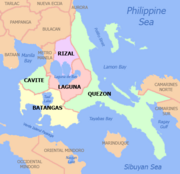CALABARZON
 |
|
| Regional center | Calamba City, Laguna |
|---|---|
| Population | 9,320,629 |
| – Density | 574.3 per km² |
| Area | 16,228.6 km² |
| Divisions | |
| – Provinces | 5 |
| – Cities | 12 |
| – Municipalities | 131 |
| – Barangays | 4,012 |
| – Cong. districts | 19 |
| Languages | Tagalog |
CALABARZON is one of the regions of the Philippines. It is also designated as Region IV-A and its regional capital is Calamba City in Laguna. The region is composed of five provinces, namely: Cavite, Laguna, Batangas, Rizal, and Quezon. The region's name is an portmanteau of the names of these provinces.
The region is located in southwestern Luzon, just south and west of Metro Manila and is the second most densely populated region.
CALABARZON and MIMAROPA were previously combined together as Southern Tagalog, until they were separated in 2002. Palawan was subsequently moved from MIMAROPA to the more logical Western Visayas, turning the former into MIMARO.
Executive Order No. 246, dated October 28, 2003, designated Calamba City as the regional center of CALABARZON.
Contents |
History
Region IV-A had a very important role in the history of the Philippines. Philippine independence was held by 1st Philippine president, Gen. Emilio Aguinaldo in Kawit, Cavite on June 12, 1898.
People from Batangas,Cavite and Laguna were a part of those who first revolted against the Spaniards for freedom. While the Philippines' national hero, Dr. Jose P. Rizal was born in Calamba, Laguna.
Political Divisions

| Province | Capital | Population (2000) |
Area (km²) |
Pop. density (per km²) |
|---|---|---|---|---|
| Batangas | Batangas City | 1,905,348 | 3,165.8 | 601.8 |
| Cavite | Trece Martires City | 2,063,161 | 1,287.6 | 1,602.3 |
| Laguna | Santa Cruz | 1,965,872 | 1,759.7 | 1,117.2 |
| Quezon | Lucena City | 1,463,030 | 8,706.6 | 171.7 |
| Rizal | Antipolo City | 1,707,143 | 1,308.9 | 1,304.3 |
| Lucena City¹ | — | 196,075 | 56.3 | 2,483 |
¹ Lucena City is a highly urbanized city; figures are excluded from Quezon Province.
Component Cities
- Antipolo City, Rizal
- Batangas City, Batangas
- Calamba City, Laguna
- Cavite City, Cavite
- Lipa City, Batangas
- San Pablo City, Laguna
- Santa Rosa City, Laguna
- Tagaytay City, Cavite
- Tanauan City, Batangas
- Tayabas City, Quezon
- Trece Martires City, Cavite
On August 7, 2000, the municipality of Los Baños, Laguna was declared as a "Special Science and Nature City of the Philippines" through Presidential Proclamation No. 349 in recognition of its importance as a center for science and technology,[1] being home to many prestigious educational, environmental and research institutions. However, this proclamation does not convert the municipality to a city, nor gives it corporate powers that are accorded to other cities.
Governors
- Erineo "Ayong" S. Maliksi (LP-A) of Cavite
- Rosa Vilma "Vi" Santos-Recto (Lakas-CMD) of Batangas
- Teresita "Ningning" S. Lazaro (Lakas-CMD) of Laguna
- Dr. Casimiro B. Ynares III (NPC) of Rizal
- Rafael "Raffy" P. Nantes (LP-D) of Quezon
References
|
|||||||||||